
- Home
- Base Metal
- Material
- Metal
- Metal Purity
- Style
- Adams (131)
- Antique (45)
- Antique Style (10)
- Art Deco (1569)
- Art Deco Style (753)
- Big Face (9)
- Cocktail (19)
- Cocktail, Art Deco (31)
- Dangle / Drop (17)
- English (14)
- French (11)
- Luxury (11)
- Luxury: Dress Styles (22)
- Mid Century (12)
- Modern (26)
- Pendant (11)
- Retro (14)
- Tiffany (8)
- Vintage (46)
- Vintage / Retro (26)
- Other (795)
- Type
- Area Rug (38)
- Armchair (70)
- Coffee Table (394)
- Console Table (29)
- Dining Table (160)
- Engagement Ring (110)
- Floor Lamp (38)
- Library Bookcase (33)
- Ring (133)
- Sculpture (36)
- Side Table (32)
- Sideboard (33)
- Sofa (42)
- Table Lamp (169)
- Tables (26)
- Wall Art (83)
- Wall Hangings (44)
- Wall Mirror (33)
- Wall Mounted (36)
- Wristwatch (227)
- Other (1814)
20thC, art deco, walnut, inverted, break front, bow front, sideboard, drawers, cupboard
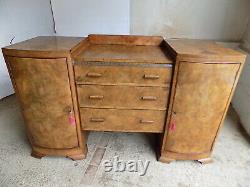
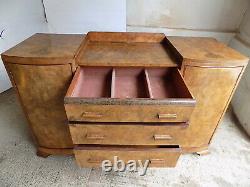
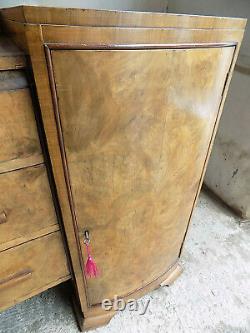
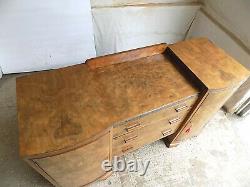
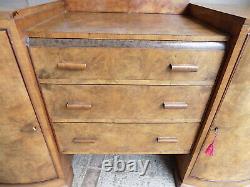
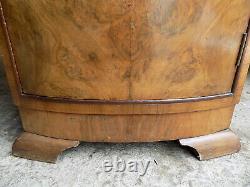
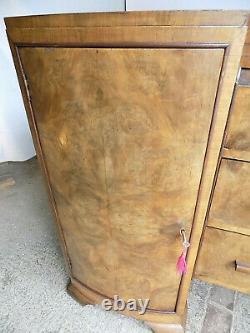
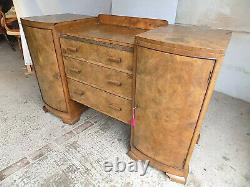
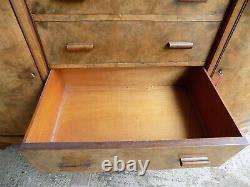

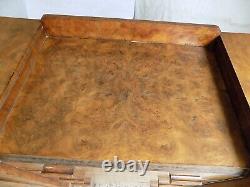
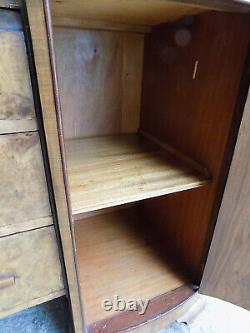


A stylish 20thC 1920's art deco walnut inverted break front sideboard with bow front cupboards either side of 3 drawers 1 a cutlery drawer in a good used condition having normal usage marks/wear re age one lock not working sizes = 150 cm w x 94 h x 53 d. Thanks for looking, please view my other items listed on my shop. We are only one ml from the A1 and have easy access and can provide assistance with loading. Measurements are taken at the widest point of all items. Please check that item can pass through any doors, hallways or stairs for it's intended location. Settlements dating as far as the Iron Age have been found in Cambridge but the modern city of Cambridge wasn? Founded until 875 AD when the Danes conquered the east of England. Throughout the Middle Ages, Cambridge was renowned as a centre for intellectual pursuits, dominated by its university which still has a reputation for excellence, not only in the UK but also internationally. Today, Cambridge is still one of the prettiest city in England, with its picturesque bridges over the Cam, King? S College cathedral and its meandering streets in the centre. Whether you live in a listed building or not, you have come to the right place if you love antiques and are looking for second-hand furniture in Cambridge. Edwardian furniture, Georgian furniture, Victorian furniture, Art Deco furniture, 1950s furniture, 1960s furniture or antique home accessories, all our pieces are and our stock changes regularly. We have clients all over the country and can deliver your antiques to you. Please contact for a quote.
Fresh and light colours composed most of the interiors in UK in this period. It was the start of a deviation from the formal to informal. Furnitures began being made of bamboo and wicker.
They were made in various styles which included baroque, rococo and empire. Georgian furniture Georgian pieces are likely to use Oak and Mahogany.
Mahogany characteristically is a hardwood, dark reddish-brown in colour which will darken over time and polishes to a reddish sheen. How do I identify my furniture? Look carefully at the bottom, sides, and back of the drawer; if the wood shows nicks or cuts, it was probably cut with a plane, a spokeshave, or a drawknife.
Straight saw marks also indicate an old piece. If the wood shows circular or arc-shaped marks, it was cut by a circular saw, not in use until about 1860. Queen Anne furniture Queen Anne style has Curved lines, in the feet, legs, arms, crest rails, and pediments, along with minimal ornament (often in a shell shape) Victorian furniture: Victorian furniture was usually made from Walnut for smaller pieces such as small tables and Mahogany for large pieces such as wardrobes, dining tables and bookcases. Sometimes these pieces featured Flame Mahogany veneers and used walnut and rosewood for decoration of for example, table tops. Chairs were more curved in design and were usually 3 main styles: the Spoon back arm chair with a buttoned or plain upholstered back rest with scrolled arms and toes, with carved legs; the nursing chair with the same style of backrest but much lower and without arms; and the balloon back chair used around a dining room table with an open circular backrest, with just the base upholstered and an open back. Antique walnut chairs Chests of Drawers were usually made of mahogany (the upmarket version) and pine (more economical) and bow fronted (out swept curving front) or were simple square fronted chests with rounded corners and edges.The feet were either raised - upon shaped block feet or turned bun feet, and were fitted with turned? As brass decorative handles were commonly used in the Georgian period, if these handles are found on a chest of drawers then they have either been added later or the chest is not Victorian. Victorian furniture is characterized by ornate carvings, dark woods, and heavy luxurious fabrics. Victorian furniture is traditionally made from mahogany, rosewood, or walnut, sometimes painted or gilded.
Intricate carvings of natural images such as flowers, leaves, curling vines, ribbons, and bows adorned the pieces. Washstands would be made from Oak or Pine Console and Hall tables and writing desks used Mahogany Centre tables and games tables were typically finished in Walnut, Rosewood or Amboyna Often Victorian tables had a very decorative carved base. T a better time to invest in this type of furniture. It is not only more beautiful, but it also holds it? S value or may even be worth more in 10 years than you paid for it.
Antiques are the ultimate ecofriendly product with the possibility of recycling them an infinite number of times. Victorian antiques have become a bargain over the last 20 years because items can be too bulky for a small house, and they aren?T from an era made trendy by the high street (such as 1950s furniture). Victorian antiques are still in good supply. Victorian furniture is often better made than older equivalents so don? Be snobby about the period. The item "20thC, art deco, walnut, inverted, break front, bow front, sideboard, drawers, cupboard" is in sale since Thursday, March 18, 2021.
This item is in the category "Antiques\Antique Furniture\Sideboards & Buffets". The seller is "steveb7599" and is located in st. This item can't be shipped, the buyer must pick up the item.
- Antique: Yes
- Width: 150cm
- Depth: 53 cm
- Product Type: sideboard
- Height: 94cm
- Type: break front sideboard
- Style: Art Deco
- Material: walnut
- Original/Reproduction: Original
- Time Period Manufactured: 20th Century

